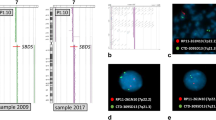Summary
DNA replication studies were carried out on the D-group chromosomes involved in the centric-fusion type chromosomal disorder in members of 5 non-related families. Ascertainement of similiar cases thus far has, almost exclusively, been achieved by investigation of non-balanced carriers. Within a total of 54 patients reported in the literature autoradiography revealed D-acrocentrics to be non-randomly involved. This might be due to ascertainement bias or to endogenous chromosomal mechanisms, as is discussed. It is considered impossible, however, to provide further evidence for the presumed excess of some types of translocation unless selection-free samples have been investigated.
Zusammenfassung
Wir berichten über autoradiographische Untersuchungen der D-Chromosomen bei 5 nichtverwandten Familien mit Fusionstranslokationen. Aus der Literatur sind bislang 54 ähnliche Fälle bekannt, die zumeist über klinisch auffällige Individuen entdeckt wurden. Innerhalb dieser Stichprobe ist die Häufigkeit, mit der bestimmte akrozentrische Chromosomen miteinander fusionieren, nicht zufällig. Als mögliche Ursachen werden einerseits die Auswahl der Stichprobe und andererseits einige cytogenetische Mechanismen diskutiert. Erst über auslesefreie cytogenetische Populationsuntersuchungen kann entschieden werden, inwieweit die in der Stichprobe beobachteten Häufigkeiten mit denen in der Durch-schnittsbevölkerung übereinstimmen.
Similar content being viewed by others
Literatur
Bloom, G. E., Gerald, P. S.: Autoradiographic studies of D chromosomes. Amer. Soc. hum. Genet. (Toronto) 1967; zit. n. Hecht, F., et al., Science 161, 371–372 (1968).
Cohen, M. M., Takagi, N., Harrod, E. K.: Trisomy D1 with 2 D/D translocation chromosomes. Report of a case. Amer. J. Dis. Child. 115, 185–190 (1968).
Court-Brown, W. M., Smith, P. G.: Human population cytogenetics., Brit. med. Bull. 25, 74–80 (1969).
De Capoa, A., Berg, W. R., Kushnick, T., Miller, O. J.: Radiographic identification of the D chromosomes involved in the centric fusion type of D/G translocation, t(DqGq). Ann. hum. Genet. 32, 191–193 (1968).
Dekaban, A. S.: Transmission of a D/D reciprocal translocation in a family with high incidence of mental retardation. Amer. J. hum. Genet. 18, 288–295 (1966).
Engel, W., Krone, W., Wolf, U.: Die Wirkung von Thioguanin, Hydroxylamin und 5-Bromdesoxyuridin auf menschliche Chromosomen in vitro. Mutat. Res. 4, 353–368 (1967).
Evans, V. J., Earle, W. R.: The use of perforated cellophane for the growth of cells in tissue culture. J. nat. Cancer Inst. 8, 103 (1947).
Giannelli, F., Howlett, R. M.: The identification of the chromosomes of the D-group (13–15) Dever: An autoradiographic and measurement study. Cytogenetics 5, 186–205 (1966).
Hamerton, J. L.: Chromosome segregation in three human interchanges. In C. D. Darlington and K. R. Lewis, eds.: Chromosomes today 1, 237–252 (1966).
—: Robertsonian translocation in man: evidence for prezygotic selection. Cytogenetics 7, 260–276 (1968).
Hecht, F., Case, M. P., Lovrien, E. W., Higgins, J. V., Thuline, H. C., Melnyk, J.: Nonrandomness of translocations in man: Preferential entry of chromosomes into 13–15/21 translocations. Science 161, 371–372 (1968).
Higurashi, M., Nakagome, Y., Nagao, T., Naganuma, M., Matsui, I.: Identification of translocated chromosomes by means of autoradiography. Paediat. Univ. Tokyo 14, 14–20 (1967).
—, Matsui, I., Nakagome, Y., Naganuma, M.: Down's syndrome: Chromosome analysis in 321 cases in Japan. J. med. Genet. 6, 401–404 (1969).
Knörr, K., Knörr-Gärtner, H., Uebele-Kallhardt, B.: Beispiel für die Bedeutung zytogenetischer Untersuchungen bei habituellen Aborten. Geburtsh. u. Frauenheilk. 29, 792–800 (1969).
Krmpotic, E., Ramanathan, K., Grossman, A.: A family with D/D translocation. J. med. Genet. 5, 205–210 (1968).
Lucas, M.: Translocation between both members of chromosome pair number 15 causing recurrent abortions. Ann. hum. Genet. 32, 347–352 (1969).
Mikkelsen, M.: Transmission of a 13–15/21 translocation in six families. Ann. hum. Genet. 30, 147–161 (1966).
—: DNA replication analysis of six 13–15/21 translocation families. Ann. hum. Genet. 30, 325–328 (1967).
Moorhead, P. S., Nowell, P. C., Mellmann, W. J., Battips, D. M., Hungerford, D. A.: Chromosome preparations of leucocytes cultured from human peripheral blood. Exp. Cell Res. 20, 613–616 (1960).
Nakagome, Y.: DNA replication studies of human D-group chromosomes in satellite associations. Cytogenetics 8, 296–303 (1969).
Östergren, G.: The mechanism of co-orientation in bivalents and multivalents. The theory of orientation by pulling. Hereditas (Lund). 37, 85–156 (1951).
Palmer, C. G., Conneally, P. M., Christian, J. C.: Translocation of D chromosomes in two families: t(13q14q) and t(13q14q)+(13p14p). J. med. Genet. 6, 166–173 (1969)
Polani, P. E., Hamerton, J. L., Giannelli, F., Carter, C. O.: Cytogenetics of Down's syndrome (Mongolism). III. Frequency of interchange trisomics and mutation rate of chromosome interchanges. Cytogenetics 4, 193–206 (1965).
Reismann, L.: zit. n. C. G. Palmer et al.: J. med. Genet. 6, 166–173 (1969).
Saksela, E., Moorhead, P. S.: Enhancement of secondary constrictions and the heterochromatic X in human cells. Cytogenetics 1, 225–244 (1962).
Schmid, W.: DNA replication patterns of human chromosomes. Cytogenetics 2, 175–193 (1963).
Schmid-Ullrich, K.: Chromosomenaberrationen an menschlichen Lymphozyten bei chronischen Arsenschäden. Dissertation, Freiburg i. Br. 1969.
Shaw, M. W., Craig, A. P., Ricciuti, F. C.: Random association of human acrocentric chromosomes. Amer. J. hum. Genet. 21, 513–515 (1969).
Tiepolo, M., Fraccaro, M., Hultén, M., Lindsten, J.: Double aneuploidy (46,XXY,D-D-,t(DqDq)+). Ann. Génét. 10, 114–117 (1967).
van Hemel, J. O., van Braink, J. M.: D/D translocation in a patient with Louis-Bar syndrome. Hum. Chrom. Newsl. 18, 26 (1966).
Wolf, U., Reinwein, H., Gey, W., Klose, J.: Cri-du-chat Syndrome mit Translokation 5/D2. Humangenetik 2, 63–77 (1966).
Yunis, J. J., Hook, E. B., Mayer, M.: Identification of the mongolism chromosome by DNA replication analysis. Amer. J. hum. Genet. 17, 191–201 (1965).
—, Alter, M., Hook, E. B., Mayer, M.: Familial D/D translocation. Report of a pedigree and DNA replication analysis. New Engl. J. Med. 271 1133–1137 (1964).
Author information
Authors and Affiliations
Additional information
Mit Unterstützung durch die Deutsche Forschungsgemeinschaft.
Rights and permissions
About this article
Cite this article
Vogel, W., Höhn, H. & Engel, W. Autoradiographische Identifizierung der an zentrischen Fusionen beteiligten D-Chromosomen bei fünf nichtverwandten Familien: t(14qGq); t(14qGq); t(15qGq); t(13q14q); t(13q15q). Hum Genet 9, 140–149 (1970). https://doi.org/10.1007/BF00278929
Received:
Issue Date:
DOI: https://doi.org/10.1007/BF00278929




